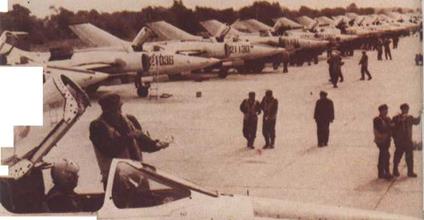Shenyang F-6 bis
F-6bis (NATO code name "Fantan A”)
Origin: State Aircraft Factory. Shenyang, People’s Republic of China. Type: All-weather fighter, attack and reconnaissance aircraft.
Engines: Two axial turbojets with afterburners (see text).
Dimensions (estimated): Span 33ft 5in (10 2m); length 50ft (15-25m); height 11ft (3-35m).
Weights: (estimated) Empty 13,6701b (6200kg): loaded (clean) 20,2851b (9200kg), (maximum) 23,6001b (10,700kg).
Performance (estimated): Maximum speed, clean (sea level) about 760mph (1225km/h. Mach 1), (high altitude) about 1,190mph (191 Okm/h. Mach 1-8): combat radius (hi-lo-hi, two bombs, two tanks) 500 miles (800km).
Armament: Not known, but almost certainly includes internal guns, external stores pylons for tanks and ordnance and comprehensive ECM equipment.
History: First flight, possibly 1968; service delivery, probably early 1970s. Users: People’s Republic of China (AF, Navy), Egypt (?).
Development: Obviously derived from the F-6, the Chinese-built MiG – 19SF, the F-6bis represents the first (enforced) attempt by the Shenyang – based home industry to produce combat aircraft independently. Despite extreme difficulties caused by a lack of industrial backing and skilled labour, the production of nationally developed aircraft was forced on the PRC (People’s Republic of China) by its isolation from technically advanced nations and imminence of the Soviet threat. The excellent qualities of the MiG-19 basic design eventually led to the F-6 being chosen for development in preference to the F-7. the illegally manufactured MiG-21 PF. During the 1960s the Shenyang F-6bis took shape as an enlarged F-6 with lateral inlet ducts feeding direct to the two engines (a Chinese illustration suggests that the mid-wing has been retained, with ducts above and below), leaving the nose free for a large search radar of unknown type. The sketch referred to showed no wing cannon, but the two 30mm NR-30s of the F-6 have probably been retained in view of the great length of inlet duct ahead of the wing, interfering with pilot view. The inlets are apparently simple and nonvariable, efficient at low level but limiting high-altitude Mach number. The radar could be a derivative of the "Spin Scan B" as used in later North Vietnamese MiG-21 PF fighters sent via China, but in the author’s opinion
|
|
is more likely to be a copy of the much more powerful AWG-10 or APQ-109 fitted to Phantoms of the late 1960s. Whether the PRC has also copied Sparrow and/or Sidewinder is problematical.
In his Fiscal Year 1977 report the US SecDef (then Donald Rumsfeld) described the "Fantan-A" as a principal tactical aircraft of the PRC Navy: earlier it was known to be in service with the PRCAF. Compared with the F-6 it should be a considerably more effective machine, provided engine power has risen at least in proportion to the weight. Some Western reports suggest that the engines are the Tumansky RD-9B-811. of 8.270lb (3750kg) maximum thrust: in the author’s view an equally plausible possibility is that the bigger and more powerful R-11 engine of the F-7 (13,1201b, 5950kg) could have been chosen. Indeed use of this engine in the F-9 might in some degree explain the early termination of Chinese production of the F-7. As this book went to press little is known of the F-6bis and it could even be subject to severe problems and limitations. It should in any case not be confused with the entirely different combat aircraft (believed to be a twin – engined delta) which will be powered by the Chinese-assembled Rolls – Royce Spey.
Below left: A line-up of F-6bis attack aircraft of the Air Force of the People’s Liberation Army of China.
Below: Bombs falling from the wing pylons of an F-6bis which also appears to have open weapon-bay doors (also seen at left).











